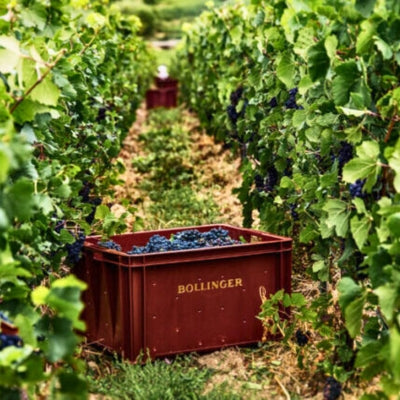
Champagne production: the grapes and the harvest
In the second part of our series on Champagne and the traditional method, Westgarth Wines wine specialist Maurizio Broggi looks at the grapes, yields, and techniques defining Champagne.
Champagne is primarily made from three grape varieties: Pinot Noir, Chardonnay, and Meunier. The Chardonnay grape is ideally suited to the production of traditional method sparkling wines, as it offers several advantages. It is an early-ripening variety, which is ideal for Champagne's cool climate. Chardonnay is harvested at a ripeness level that produces just-ripe flavors and low sugar levels while retaining high acidity. Its subtle apple and citrus notes complement the autolytic flavors of brioche, bread, and dough that develop from lees aging, making it an essential component of high-quality, elegant traditional method sparkling wines.
Of the three main grape varieties, Pinot Noir is the most widely planted in Champagne. Like Chardonnay, it is also early-ripening and is therefore well-suited to Champagne’s cool conditions. Pinot Noir is predominantly grown in the Montagne de Reims and the Côte des Bar, where it thrives on chalky, limestone-rich soils that enhance the grape’s concentration and complexity. In the blend, Pinot Noir provides weight, body, and rich flavors of red berries and stone fruits, along with the potential for increased aging capacity. It is an essential component in the production of prestigious cuvées, particularly Blanc de Noirs, which are made exclusively from black grape varieties.
Meunier (previously known as Pinot Meunier) is a black grape variety that is a mutation of Pinot Noir. Although less prized than Chardonnay and Pinot Noir, Meunier has the advantage of being later-budding, which protects it from spring frosts, particularly in the Vallée de la Marne sub-region. Meunier provides youthful fruitiness fruit, softness, and approachability to the blend, which is especially useful in non-vintage wines. While Pinot Meunier is often used in early drinking Champagne, top producers such as Krug and Egly-Ouriet recognize its importance as a key balancing component in the blend.
The harvest
Harvest dates in Champagne are determined by the Comité Champagne, which is responsible for setting both the start of the harvest and the permitted yields for each vintage. This decision is based on the specific grape variety, rootstocks, as well as analysis of grape samples from hundreds of control plots, where key parameters such as color, average berry weight, sugar concentration, and acidity levels are monitored.
Based on this data, the Comité Champagne announces the official harvest start date for each grape variety and subregion. By doing so, they ensure that all producers pick at optimal ripeness, preserving the critical balance of sugar and acidity required for Champagne production.
Yield regulations
Champagne yields are strictly regulated to serve multiple purposes. This regulation helps maintain grape quality by preventing over-cropping, protects the market value of Champagne, balances supply and demand, and ensures that a portion of the crop is reserved as reserve wine. The reserve stock can then be used to compensate for future crop failures or lower-quality vintages.
Champagne regulations also require the use of whole-bunch pressing, which is why grapes must be picked by hand. Whole-bunch pressing minimizes crushing, reducing the risk of oxidation and microbial spoilage, thereby preserving the freshness and quality of the fruit. It is essential for maintaining Champagne’s signature freshness and finesse, as it allows the gentle extraction of juice from the grapes while avoiding the harsh flavors that come from crushed skins, seeds, or stems.
See also Part I: Inside Champagne: sub-regions and “ladders of growth”
Stay tuned for Part III which explains what makes the traditional method so special.
Want to read more? Take a look at some of our other blogs:



